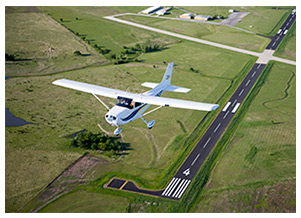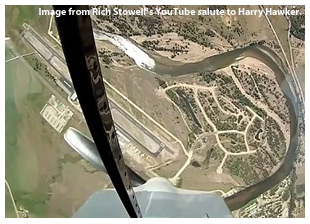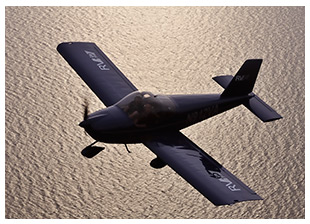Training Tips
|

A good track
The student pilot's takeoff at the beginning of a session of checkride prep has been smooth and precise. Climbing smartly to a safe altitude, she guards the throttle with her right hand, taking a moment to trim off excess back-elevator pressure as the trainer climbs.
With the runway now out of sight behind the trainer, the pilot trainee lowers the nose briefly to clear the area ahead for traffic. Then she takes a quick glance back in the direction of the departure runway.
Why the rearward glance? To confirm that the aircraft is tracking the runway's extended centerline—especially if the takeoff was performed in a crosswind.
"The climb with a wind correction angle should be continued to follow a ground track aligned with the runway direction," notes Chapter 5 of the Airplane Flying Handbook. "However, because the force of a crosswind may vary markedly within a few hundred feet of the ground, frequent checks of actual ground track should be made, and the wind correction adjusted as necessary."
No crosswind raking the runway today? That's no reason to neglect ground track. (Failing to check the track is a commonly observed error.) The aircraft's gyroscopic heading indicator may not yet be providing completely accurate directional information. Or, if your initial heading wandered a bit during the departure, your aircraft could already be misaligned with the departure course.
Keeping the aircraft positioned above the extended centerline of the departure runway is good practice for safety, the trainee's instructor says. But if an airport control tower instructs you to "fly runway heading" after takeoff, should you still include a wind correction angle in your tracking method?
"No," replies the student pilot, citing guidance from the Pilot/Controller Glossary: "When cleared to 'fly or maintain runway heading,' pilots are expected to fly or maintain the heading that corresponds with the extended centerline of the departure runway. Drift correction shall not be applied; e.g., Runway 4, actual magnetic heading of the runway centerline 044, fly 044."
If your training is based at a large, spacious airport, you may not fully appreciate the importance of your tracking skills until you make your first takeoff from a small airfield bounded closely by tall trees, or with obstructions lining the departure course. Then you will be thankful that a good track has been second nature since your earliest training.
|
|
Flight Training News
|
|
Article
A portable, turnkey flight simulator designed for classroom use is showing students at schools in Connecticut and New York how much fun flying can be.
Read more...
 
Apps of the week
Developers present apps that do everything from connect with the X-Plane PC flight simulator to share pilot reports. Read more...
 
Article
Aviation students enrolled at Ohio's Bowling Green State University will now take flight lessons through partner North Star Aviation's new Bowling Green Flight Center. Read more...
 

Article
Veteran CFI Rich Stowell paid tribute to Harry Hawker with a power-off spin, creating a video that is part salute, part message to pilots.
Read more...
 
Video
Living on the edge is not without its perils. Some are minor, but some can be downright dangerous. Take thunderstorms for instance: Watch this Air Safety Institute Pilot Safety Announcement to see what happens when you venture too close to turbulence associated with a storm.
Watch the video...
 
Article
Blue skies and temperatures in the 70s greeted about 2,250 visitors to the third 2014 AOPA Fly-In in Plymouth, Massachusetts, July 12.
Read more...
 
Blog
Airports have personalities, and that has made each of this year's AOPA Fly-Ins a special experience, writes AOPA President Mark Baker. While there are regional differences in how we fly, there are huge similarities in why we fly.
Read more...
 
|
Training Resources
|
|
Video
Did you know that general aviation accounts for 75 percent of all runway incursions? Listen to what an air traffic controller has to say about pilots who think they know the airport and mess things up because they really don't know where they are or where they're supposed to go.
Read more...
 
PDF
An overwhelming desire to sleep is the most pronounced symptom of fatigue, and it's a decidedly uncomfortable feeling when you're at the controls of an airplane. In reality, though, there's a lot more to fatigue than the risk of dozing off in the cockpit. This Air Safety Institute Safety Brief looks at some of the things that can lead to fatigue, and some ways to keep it from catching up with you in the cockpit.
Download the brief...
|
|
Did you know that student pilots who join AOPA are three times more likely to complete their flight training? Membership includes unlimited access to aviation information by phone (800/USA-AOPA, weekdays from 8:30 a.m. to 8 p.m. Eastern time) or from Flight Training Online or AOPA Online. If you're not already a member, join today and get the pilot's edge.
|
AOPA Live
|
|
AOPA Live This Week
A new single-seat personal jet from Sonex flies, and even does aerobatics on its first flight. It's almost time to award the AOPA Sweepstakes Debonair; see how "your" airplane looks over the Big Apple. AOPA has an update on the search for a replacement for 100LL, and it's good news. Plus, AOPA Live® takes a look at the army of green shirts that help make the AOPA Regional Fly-Ins possible.
AOPA Live This Week®, July 17...
 
|
|
Career Pilot
|
Reminder: Test now to beat ATP rule change
Pilots who plan to earn a multiengine airplane airline transport pilot certificate within the next couple of years should take the ATP knowledge test before Aug. 1, when new rules will extend the training process and could significantly increase costs, AOPA is recommending. Changes resulting from the new Pilot Certification and Qualification Requirements for Air Carrier Operations will require first officers to hold an ATP certificate—meaning that they must have at least 1,500 hours total time—when hired. Lower time allowances for a restricted ATP certificate can be given to university graduates and military pilots. Although the rule primarily will affect air carriers and is specific to multiengine airplane, AOPA is concerned about the impact it could have on Part 61 flight training providers; many could be essentially excluded from airline-career training because of the higher time requirements for their customers.
Article
Embry-Riddle Aeronautical University's airline transport pilot certification program has received FAA approval, the university announced July 8.
Read more...
 
Business aviation market rising, survey shows
The business aviation market shows signs of upward movement, according to JetNet iQ's most recent industry survey, Aviation International News Online reported July 6. The inventory of preowned business jets, which peaked at 18 percent in 2009 and has been declining steadily since, is still about a year from resuming normal levels, according to Rolland Vincent, JetNet iQ creator and director. He noted that while markets such as China and Hong Kong, India, Saudi Arabia, and Mexico are forecast to see 3 percent or better growth in gross domestic product this year—a threshold correlating to increased business aviation activity—they represent only 7.5 percent of the world business jet fleet.
|
|
For more aviation career news, see the Flight Training website.
|
Plane Spotter
|

Van's versatility
If experimental and light sport aircraft are subspecialties of the plane spotter's craft, another level of expertise is the ability to identify individual models turned out by a single manufacturer. The oft-spotted RV line from Aurora, Oregon-based Van's Aircraft poses the proper challenge: From speedy single-seat RV-3s to the latest member of the family, the four-place RV-14, about 8,000 Van's kits have been assembled. The 100-horsepower, two-seat, side-by-side RV-12 made news as Richard VanGrunsven's company's first factory-built model, a tricycle-gear design that meets certification standards as a light sport aircraft.
|
Training Products
|
AEA to release new avionics book in August
The Aircraft Electronics Association will release the 2014-15 edition of the Pilot's Guide to Avionics in early August. The book was created to help pilots make better avionics buying decisions and to locate the repair stations certified by international regulatory authorities as capable of installing and maintaining these sophisticated pieces of equipment. Single copies of the book can be shipped for free in the United States.
ASA releases Pilot's Manual series on iBooks
ASA has put its Pilot's Manual series on iBooks. The books provide readers with comprehensive coverage of the practical aspects of flying and have been edited by a team of airline, military, and professional pilots; flight instructors; university professors; FAA representatives; meteorologists; members of the AOPA Foundation's Air Safety Institute; and designated examiners.
|
|
Note: Products listed have not been evaluated by ePilot editors unless otherwise noted. AOPA assumes no responsibility for products or services listed or for claims or actions by manufacturers or vendors.
|
Member Benefits
|
|
Members only
Here are some ways you might defer, if not defeat, the man with the sickle.
Read more...
 
Member benefits
Most renters do not understand what coverage they actually need for an airplane. AOPA Insurance Services is offering a webinar July 24 to help answer questions about renter's insurance and to help you understand which policy is best for you.
Read more...
 
|
Blogs
|
|
Opinion Leaders blogger Martin Rottler writes about his summer as visiting professor for Korea Aerospace University's international summer program and his recent flight experience there.
Read more...
 
|
Instrument Tip
|
|
IFR Fix
In the satellite age, it's still true that the less precision exists for navigation, the more precise the flying must be. Read more...
 
|
Final Exam
|
Question
How much time is recommended for a pilot to allow his or her eyes to adapt to the darkness before going on a night flight?
Answer
The FAA recommends 30 minutes of adaptation time. This amount of time allows for the rods in the human eye to become about 100,000 times more sensitive to light. (Source: Airplane Flying Handbook, Chapter 10.)
|
|
Got a question for our technical services staff? Contact AOPA.
|
Career Opportunities
|
|
AOPA career opportunities
Ever dream of turning your passion for aviation into a career? We're looking for a human resources assistant, payroll technician, contract Air Safety Institute presenter, aviation technical specialist, Air Safety Institute intern, member services representative, major gift officer, AOPA Live producer/videographer I, and account manager II. To learn more about other AOPA career opportunities, visit AOPA Online.
|
 |
Education and Seminars
|
Flight Instructor Refresher Courses
July 19-20 - Jacksonville, Florida; and Newark, New Jersey
Aug 2-3 - Fort Worth, Texas
Aug 9-10 - Reno, Nevada; and Allentown, Pennsylvania
Aug 16-17 - Atlanta, Georgia
For a complete schedule, see AOPA Online. Can't make it in person? Sign up for the Air Safety Institute's new Online eFIRC.
|
Air Safety Institute Safety Seminars
July 31-Aug 2 - Oshkosh, Wisconsin
Sep 2 - Germantown, Tennessee
Sep 3 - Salt Lake City, Utah; and Murfreesboro, Tennessee
Sep 4 - Boise, Idaho; and Maryville, Tennessee
Topics vary—for details and a complete schedule, see AOPA Online.
|
Rusty Pilot Seminars
July 19 - Englewood, Colorado; Hillsboro, North Dakota; and Burlington, Washington
July 23 - Palo Alto, California
July 24 - Kansas City, Missouri
July 26 - Zionsville, Indiana
July 30 - Oshkosh, Wisconsin
For a complete schedule, see AOPA Online.
|
|
Aviation Calendar
|
|
Want something to do this weekend? Planning an aviation getaway? See AOPA's enhanced calendar of events. Now you can filter events by date range, airport ID, state, or region. Before you take off on an adventure, make sure you check our current aviation weather provided by Jeppesen.
To include an event or to search all events in the calendar, visit AOPA Online. For airport details, including FBO fuel prices, see AOPA Airports.
AOPA Featured Events
Aug 16 — Spokane, Washington. Spokane Felts Field (KSFF). AOPA Fly-In.
Sep 20 — Chino, California. Chino Airport (KCNO). AOPA Fly-In.
Oct 4 — Frederick, Maryland. Frederick Municipal Airport (KFDK). AOPA Homecoming.
Nov 8 — Brunswick, Georgia. Malcom McKinnon Airport (KSSI). AOPA Fly-In.
|
|
|
|
|
 |
|
|
ePilot Flight Training Editor:
Benét Wilson
Production Assistant:
Melissa Whitehouse |
Contributors:
Sarah Deener
Alyssa Miller
Jim Moore
Jill W. Tallman
Warren Morningstar
Alton K. Marsh
Dave Hirschman
Tom Horne
Ian J. Twombly
Dan Namowitz |
|
|
|
|